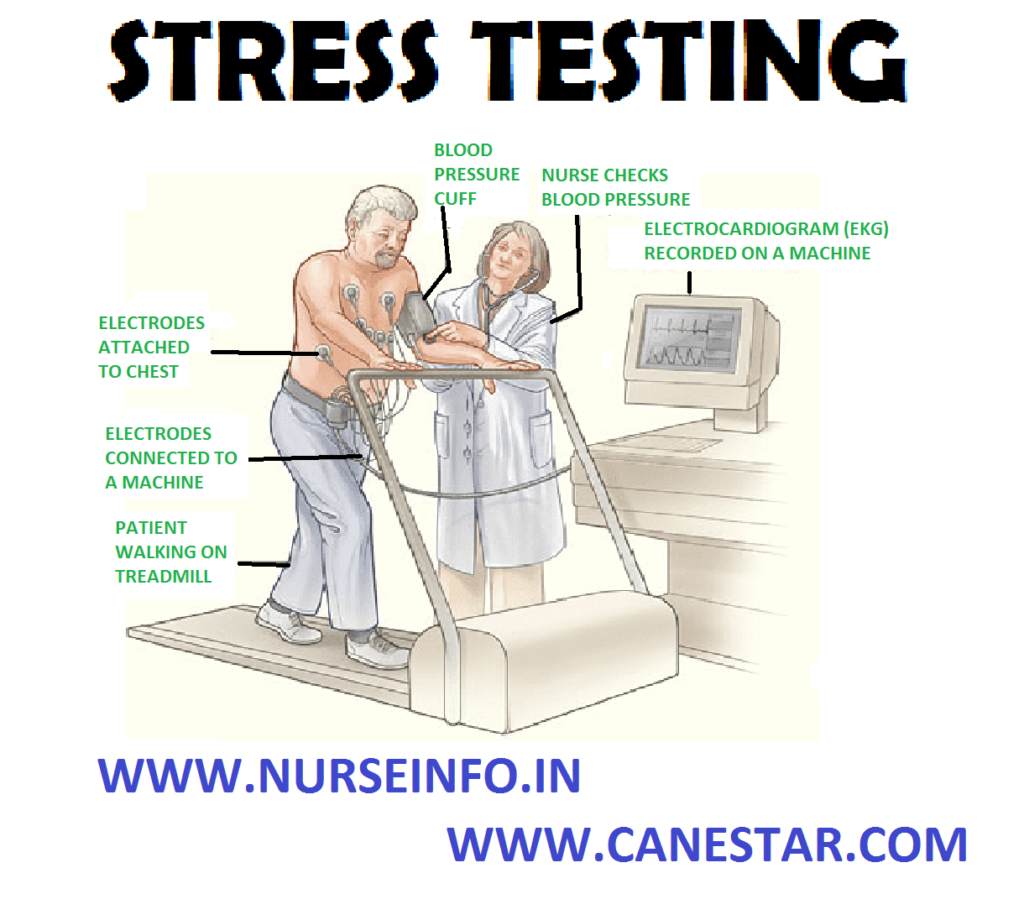STRESS TESTING – Purpose, Indications, Interfering Factors, Client Preparation, Procedure, Findings, After Care and Contraindications
Stress testing is an important noninvasive procedure for evaluating the cardiovascular status of clients who are known to have cardiac disease or who are at risk for cardiac diseases. The test increases the demand placed on the heart by increasing physical activity. Through electrocardiography tracings, it is determined whether the heart is able to meet the increased oxygen demand
PURPOSE
- To assess the at-risk population
- Diagnosing chest pain syndromes and dysrhythmia associated with ischemia
- Evaluating the effectiveness of therapy (surgical or pharmacological)
- Identifying the initial level of function in cardiac rehabilitation programs and evaluating the results
INDICATIONS
Class – I (Clear Indications for Stress Testing)
- Suspected or proven coronary artery disease
- Male client who present with atypical chest pain
- Evaluate functional capacity and assess prognosis of clients with coronary artery disease (CAD)
- Clients with exercise related palpitation, dizziness or syncope
- Evaluate of recurrent exercise-induced arrhythmias
Class – II (Stress Testing may be Indicated)
- Evaluation of typical or atypical symptoms in women
- Evaluation of variant angina
- Evaluation of clients who are on digoxin preparations or who have a right bundle-branch block
Class – III (Stress Testing is Probably Necessary)
- Young or middle-age asymptomatic clients who have no risks factors for CAD
- Young or middle-age asymptomatic clients
INTERFERING FACTORS
- Severe anxiety may interfere with the client’s ability to participate fully in the stress testing
- False-positive results may due to bundle branch block, ventricular hypertrophy or digitalization
- False-negative results may be due to the use of beta-blockers
CLIENT PREPARATION
- Inform the client about purpose and procedure of the test
- Instruct the client to wear comfortable cloths and rubber-soled walking shoes
- Instruct the client not to eat, smoke or drink alcohol for 3-4 hours before the test
- If adenosine stresses testing being done, instruct the client to avoid theophylline-based drugs, diyridamole, over-the-counter drugs and caffeine for 24 hours
- Routine cardiac medications are usually continued
- Assess the following contraindications: chest pain, hypertension, thrombophlebitis, second or third degree heart block, serious dysrhythmia, and severe congestive heart failure, neurological, musculoskeletal or vascular problems that would impede mobility on the bicycle or treadmill
- Warn the client that he or she will feel his or her racing and instruct the client to report chest pain during the procedure
- Have emergency equipment and drug available
- The client is attached to electrodes for recording a 12 lead ECG
- A blood pressure cuff is put in place for quick access. A baseline blood pressure reading is obtained
PROCEDURE
- Stress testing requires the use of a bicycle ergometer or a treadmill with continuous electrocardiac recording
- The test is performed in a series of stages in which the client exercise for 3 minutes. Verities of protocols are used in stress testing
- The Bruce protocol involves gradual increase in speed and intervals of short duration
- At the end of each stage, a 12 lead ECG is recorded. After each stage, the work load or graded load is increased
- This is accomplished by increasing the speed or resistance of the bicycle or treadmill
- The stress testing continues until the client reaches 85% of the maximum heart rate, becomes symptomatic or displays electrocardiography changes consistent with ischemia
- The maximum heart rate is usually determined by normograms. A gross estimate of the maximum heart rate is 220 beats per minute the client’s age
- If the client is physically unable to exercise to the point of 85% of the maximum heart rate, a dipyridamole (persantine) scan may be performed
- Dipyridamole may be given intravenously or by mouth. It causes coronary artery dilatation similar to the response of the coronary arteries to exercise
- As the graded exercise begins, a multichannel ECG is recorded. A 12 lead ECG is recorded and the blood pressure is checked as each workload ends (every 3 minute increment)
- Observe for signs to stop the stress testing, for example, falling blood pressure, three consecutive premature ventricular contractions, chest pain or exhaustion
FINDINGS
A 1 mm depression of the ST-segment is positive stress test, indicating myocardial ischemia
AFTER CARE
- Cardiac monitoring is continued for 5-10 minutes after the testing to evaluate the client’s physiologic responses
- Blood pressure is checked
- Remove conduction jelly and assist in robbing the client if necessary
- Evaluate the client’s physical and emotional response to testing
- Instruct the client to rest and not to take hot shower or baths for 2-4 hours
CONTRAINDICATIONS
- Uncontrolled arrhythmias
- Uncorrected valvular diseases
- Cardiomegaly
- Severe anemia
- Unstable angina
- Uncontrolled hypertension
- Congestive heart failure
- Pericarditis and myocarditis


